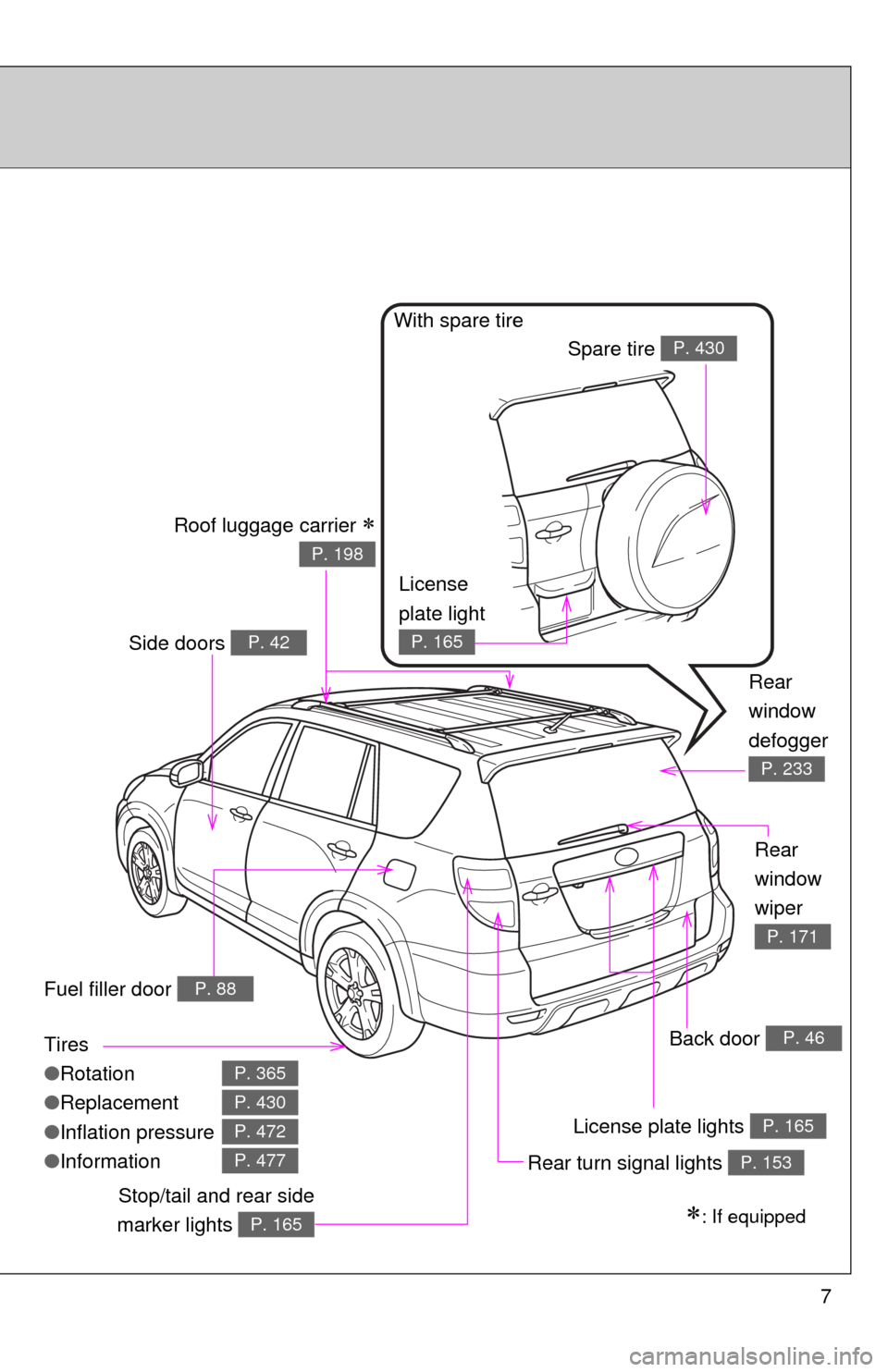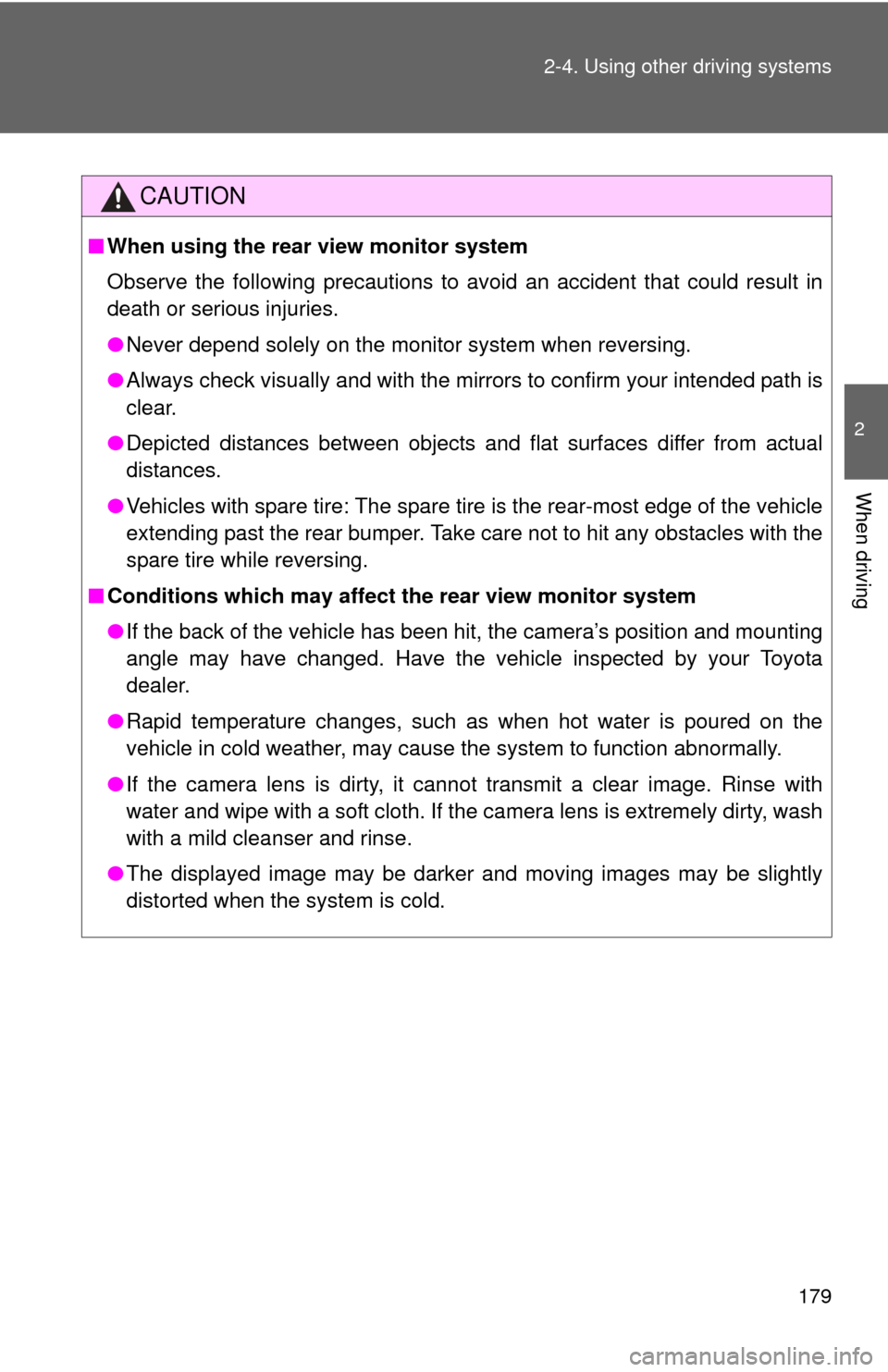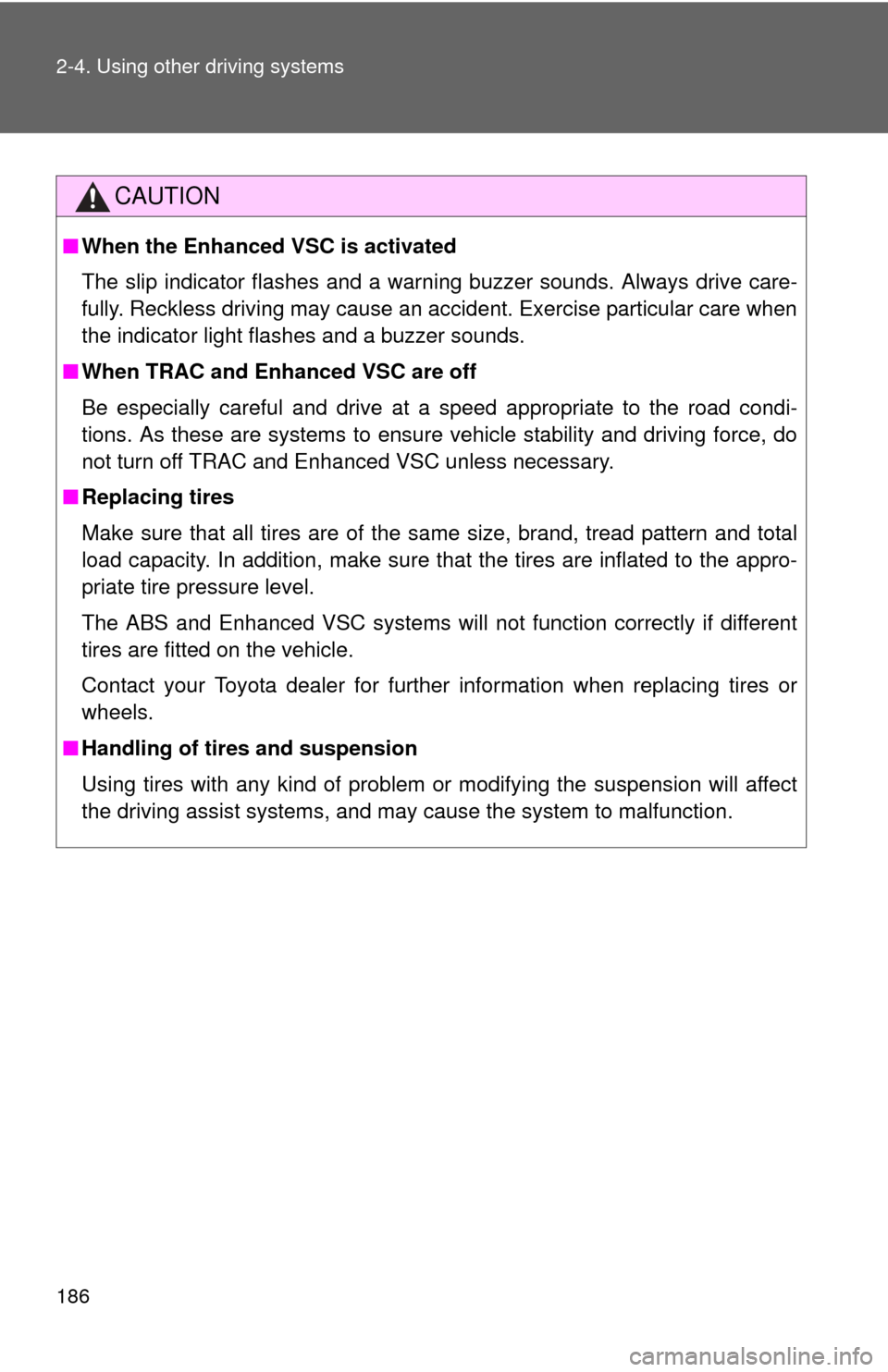2010 TOYOTA RAV4 flat tire
[x] Cancel search: flat tirePage 1 of 513

TABLE OF CONTENTS
1
1Before drivingAdjusting and operating features such as door locks,
mirrors, and steering column.
2When drivingDriving, stopping and safe-driving information.
3Interior
featuresAir conditioning and audio systems, as well as other
interior features for a comfortable driving experience.
4Maintenance
and careCleaning and protecting your vehicle, performing do-it-
yourself maintenance, and maintenance information.
5When trouble
arisesWhat to do if the vehicle needs to be towed, gets a flat
tire, or is involved in an accident.
6Vehicle
specificationsDetailed vehicle information.
7For ownersReporting safety defects for U.S. owners and seat belt
instructions for Canadian owners
IndexAlphabetical listing of information contained in this
manual.
Page 4 of 513

TABLE OF CONTENTSIndex
4
Security and system setup ................................ 289
Using the phone book ........ 292
3-4. Using the interior lights Interior lights list ................. 300
• Personal/interior light main switch ...................... 301
• Personal/interior lights...... 301
• Interior light ...................... 302
• Luggage compartment light .................................. 302
3-5. Using the storage features List of storage features....... 304
• Glove box ......................... 305
• Console box ..................... 306
• Overhead console ............ 307
• Cup holders ...................... 308
• Bottle holders ................... 309
• Auxiliary box ..................... 311
3-6. Other interior features Sun visors .......................... 312
Vanity mirrors ..................... 313
Clock .................................. 314
Power outlets ..................... 315
Seat heaters ....................... 318
Armrest............................... 320
Coat hooks ......................... 321
Floor mat ............................ 322
Luggage compartment features ............................ 323 4-1. Maintenance and care
Cleaning and protecting the vehicle exterior ........... 330
Cleaning and protecting the vehicle interior ............ 333
4-2. Maintenance Maintenance requirements .................... 336
General maintenance ......... 338
Emission inspection and maintenance (I/M)
programs .......................... 341
4-3. Do-it-yourself maintenance Do-it-yourself service precautions ....................... 342
Hood ................................... 346
Positioning a floor jack........ 348
Engine compartment .......... 350
Tires.................................... 365
Tire inflation pressure ......... 372
Wheels................................ 376
Air conditioning filter ........... 378
Key battery ......................... 380
Checking and replacing fuses ................................. 384
Light bulbs .......................... 396
4Maintenance and care
Page 5 of 513

1
2
3
4
5
6
7
5
5-1. Essential informationEmergency flashers ............ 406
If your vehicle needs to be towed ........................... 407
If you think something is wrong ............................ 414
Fuel pump shut off system .............................. 415
Event data recorder ............ 416
5-2. Steps to take in an emergency
If a warning light turns on or a warning buzzer
sounds... .......................... 418
If you have a flat tire (vehicles with standard
tires) .................................. 430
If you have a flat tire (vehicles with run-flat
tires) .................................. 447
If the engine will not start .... 448
If the shift lever cannot be shifted from P.................... 449
If you lose your keys ........... 450
If the electronic key does not operate properly.......... 451
If the battery is discharged ........................ 453
If your vehicle overheats ..... 456
If the vehicle becomes stuck ................................. 458
If your vehicle has to be stopped in an
emergency ........................ 459 6-1. Specifications
Maintenance data (fuel, oil level, etc.) ........... 462
Fuel information.................. 474
Tire information .................. 477
6-2. Customization Customizable features........ 488
6-3. Initialization Items to initialize ................. 491
Reporting safety defects for U.S. owners ................ 494
Seat belt instructions for Canadian owners
(in French) ........................ 495
Abbreviation list ......................... 498
Alphabetical index ..................... 500
What to do if... ........................... 509
5When trouble arises6Vehicle specifications
7For owners
Index
Page 7 of 513

7
Tires
●Rotation
● Replacement
● Inflation pressure
● Information
P. 365
P. 430
P. 472
P. 477
Back door P. 46
Rear turn signal lights P. 153
: If equippedStop/tail and rear side
marker lights
P. 165
Rear
window
wiper
P. 171
License plate lights P. 165
Side doors P. 42
Rear
window
defogger
P. 233
License
plate light
P. 165
With spare tire Spare tire
P. 430
Fuel filler door P. 88
Roof luggage carrier
P. 198
Page 141 of 513

141
2-1. Driving procedures
2
When driving
NOTICE
■
When driving the vehicle
Do not use the accelerator pedal or depress the accelerator and brake ped-
als together to hold the vehicle on a hill.
■ When parking the vehicle
Always put the shift lever in P. Failure to do so may cause the vehicle to
move or the vehicle may accelerate suddenly if the accelerator pedal is acci-
dentally depressed.
■ Avoiding damage to vehicle parts
●Do not turn the steering wheel fully in either direction and hold it there for a
long time.
Doing so may damage the power steering motor.
● When driving over bumps in the road, drive as slowly as possible to avoid
damaging the wheels, underside of the vehicle, etc.
■ If you hear a squealing or scraping noise (brake pad wear limit indica-
tors)
Have the brake pads checked and replaced by your Toyota dealer as soon
as possible.
The rotor damage can result if the pads are not replaced when needed.
It is dangerous to drive the vehicle when the wear limits of the brake pads
and/or those of the brake discs are exceeded.
■ If you get a flat tire while driving
A flat or damaged tire may cause the following situations. Hold the steering
wheel firmly and gradually press the brake pedal to slow down the vehicle.
●It may be difficult to control your vehicle.
● The vehicle will make abnormal sounds.
● The vehicle will behave abnormally.
Replace the flat tire with a new one. ( P. 435)
Page 179 of 513

179
2-4. Using other
driving systems
2
When driving
CAUTION
■When using the rear view monitor system
Observe the following precautions to avoid an accident that could result in
death or serious injuries.
●Never depend solely on the monitor system when reversing.
● Always check visually and with the mirrors to confirm your intended path is
clear.
● Depicted distances between objects and flat surfaces differ from actual
distances.
● Vehicles with spare tire: The spare tire is the rear-most edge of the vehicle
extending past the rear bumper. Take care not to hit any obstacles with the
spare tire while reversing.
■ Conditions which may affect the rear view monitor system
● If the back of the vehicle has been hit, the camera’s position and mounting
angle may have changed. Have the vehicle inspected by your Toyota
dealer.
● Rapid temperature changes, such as when hot water is poured on the
vehicle in cold weather, may cause the system to function abnormally.
● If the camera lens is dirty, it cannot transmit a clear image. Rinse with
water and wipe with a soft cloth. If the camera lens is extremely dirty, wash
with a mild cleanser and rinse.
● The displayed image may be darker and moving images may be slightly
distorted when the system is cold.
Page 186 of 513

186 2-4. Using other driving systems
CAUTION
■When the Enhanced VSC is activated
The slip indicator flashes and a warning buzzer sounds. Always drive care-
fully. Reckless driving may cause an accident. Exercise particular care when
the indicator light flashes and a buzzer sounds.
■ When TRAC and Enhanced VSC are off
Be especially careful and drive at a speed appropriate to the road condi-
tions. As these are systems to ensure vehicle stability and driving force, do
not turn off TRAC and Enhanced VSC unless necessary.
■ Replacing tires
Make sure that all tires are of the same size, brand, tread pattern and total
load capacity. In addition, make sure that the tires are inflated to the appro-
priate tire pressure level.
The ABS and Enhanced VSC systems will not function correctly if different
tires are fitted on the vehicle.
Contact your Toyota dealer for further information when replacing tires or
wheels.
■ Handling of tires and suspension
Using tires with any kind of problem or modifying the suspension will affect
the driving assist systems, and may cause the system to malfunction.
Page 212 of 513

212 2-5. Driving information
HitchTrailer hitch assemblies have different weight capacities established
by the hitch manufacturer. Even th ough the vehicle may be rated for
towing a higher weight, the operat or must never exceed the maxi-
mum weight rating specified for the trailer hitch.
■ Before towing
●Ensure that your vehicle’s tires are properly inflated. ( P. 472)
● Trailer tires should be inflated according to the trailer manufacturer's rec-
ommendation.
● All trailer lights must work in order to be legal.
● Confirm all lights work each time you connect them.
● Check that your vehicle remains level when a loaded or unloaded trailer
is hitched. Do not drive if the vehicle is not level, and check for improper
tongue load, overloading, worn suspension, or other possible causes.
● Make sure the trailer cargo is securely loaded.
● Check that your rear view mirrors conform to any federal, state/provincial
or local regulations. If they do not, install rear view mirrors appropriate for
towing purposes.
■ Break-in schedule
Toyota recommends that you do not use a new vehicle or a vehicle with any
new power train components (engine, transmission, differential, wheel bear-
ings, etc.) to tow a trailer for the first 500 miles (800 km) of driving.
■ Maintenance
●If you tow a trailer, your vehicle will require more frequent maintenance
due to the additional load. (See “Scheduled Maintenance Guide” or
“Owner's Manual Supplement”.)
● Retighten the fixing bolts of the towing ball and bracket after approxi-
mately 600 miles (1000 km) of trailer towing.